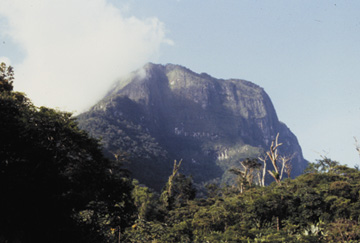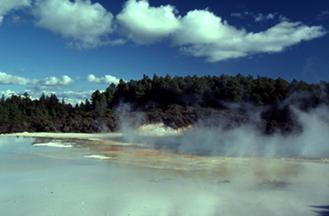Every month, we'd like to feature one of your photos from anywhere in the world and invite other readers to guess where it was taken. Look every month in the print Geotimes for a new photo. Following are clues, answers and winners from past issues.


| Do you have slides and photos
you've collected from field work or vacations?
Every month, we'd like to feature one of your photos from anywhere in the world and invite other readers to guess where it was taken. Look every month in the print Geotimes for a new photo. Following are clues, answers and winners from past issues. |
 |
| Send answers for the November 2002 Where on Earth?
contest, which appears the print magazine, to Geotimes by Nov. 25 (or postmarked
by this date). From those answers, Geotimes staff will draw the names of
10 people who will win Where on Earth? T-shirts. And from those 10 names,
we will draw the names of two people who will win a Brunton
compass.
Click here
to submit a guess for this month's Where on Earth?
contest.
Submit
photos for Where on Earth? |

|
Clues:
1. As impressive as this cliff looks, what is truly impressive is down below — the deepest known cave in the Western Hemisphere. 2. The cliff and cave are part of a karst terrain formed in Cretaceous limestone. 3. A fatal 1994 expedition established a new hemispheric record for the deepest that humans have traversed underground. Name the body of water. Scroll down for the answer
|
|
Answer: Huautla Plateau, Oaxaca, Mexico |
November winners:
1. Dan Bulger (Waukegan, IL)
2. Bruce Johnson (Naples, FL)
3. Suzie Opalka (Hollis, NH)
4. Mike Ranck (Socorro, NM)
5. Frank Lynham (Westbrook, ME)
6. Harry TerBest, Jr. (Franktown, CO)
7. Steven Paul Rewa (East Lansing, MI)
8. Jim Sukup (Carmel, IN)
9. Louise Hose (Orange, CA)
10. Arthur N. Palmer (Oneonta, NY)

|
Clues:
1. Part of an area called “sacred waters”
in the local language, this spring is 25 kilometers south of an island
city founded in the 14th century. 2. The bubbly, hot spring pool derives its name from the character of its thermal waters. Fed by groundwater, it sits in a hydrothermal eruption crater that formed about 900 years ago. 3. Orange precipitates visible around the rim of the pool are rich in arsenic, antimony, mercury and thallium, and contain ore grades of gold and silver. This suite of elements highlights the fact that this geothermal system is an active analogue of systems that form epithermal gold deposits in volcanic arcs.
Scroll down for the answer
|
|
Answer: Champagne Pool hot spring in the Waiotapu Thermal Reserve, Central North Island, New Zealand. Supplied by Jeff Hedenquist of Ottawa, Canada. |
October Winners:
1. Rick Allis, Salt Lake City, Utah
2. Raili Aumo, Espoo, Finland
3. John Balla, Spokane, Wash.
4. Steve Blair, Edmond, Okla.
5. Kurt Brownell, La Crosse, Wis.
6. Sandra Cannon, Oceanside, Calif.
7. Remi duBois, Bellows Falls, Vt.
8. L. Duane Dungan, Cape Coral, Fla.
9. Aaron R. Phillips, Joplin, Mo.
10. Thomas L. Shaw, Lakeland, Fla.
 |
Geotimes Home | AGI Home | Information Services | Geoscience Education | Public Policy | Programs | Publications | Careers |